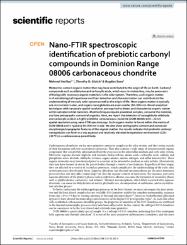| dc.contributor.author | Yeşiltaş, Mehmet | |
| dc.contributor.author | Glotch, Timothy D. | |
| dc.contributor.author | Sava, Boğdan | |
| dc.date.accessioned | 2021-12-12T17:03:21Z | |
| dc.date.available | 2021-12-12T17:03:21Z | |
| dc.date.issued | 2021 | |
| dc.identifier.issn | 2045-2322 | |
| dc.identifier.uri | https://doi.org/10.1038/s41598-021-91200-8 | |
| dc.identifier.uri | https://hdl.handle.net/20.500.11857/3660 | |
| dc.description.abstract | Meteorites contain organic matter that may have contributed to the origin of life on Earth. Carbonyl compounds such as aldehydes and carboxylic acids, which occur in meteorites, may be precursors of biologically necessary organic materials in the solar system. Therefore, such organic matter is of astrobiological importance and their detection and characterization can contribute to the understanding of the early solar system as well as the origin of life. Most organic matter is typically sub-micrometer in size, and organic nanoglobules are even smaller (50-300 nm). Novel analytical techniques with nanoscale spatial resolution are required to detect and characterize organic matter within extraterrestrial materials. Most techniques require powdered samples, consume the material, and lose petrographic context of organics. Here, we report the detection of nanoglobular aldehyde and carboxylic acids in a highly primitive carbonaceous chondrite (DOM 08006) with similar to 20 nm spatial resolution using nano-FTIR spectroscopy. Such organic matter is found within the matrix of DOM 08006 and is typically 50-300 nm in size. We also show petrographic context and nanoscale morphologic/topographic features of the organic matter. Our results indicate that prebiotic carbonyl nanoglobules can form in a less aqueous and relatively elevated temperature-environment (220-230 degrees C) in a carbonaceous parent body. | en_US |
| dc.description.sponsorship | RISE2 node of NASA's Solar System Exploration Research Virtual Institute (SSERVI) | en_US |
| dc.description.sponsorship | We thank the associate editor and the reviewers for their constructive comments, which significantly improved this manuscript. We thank NASA-JSC for providing the meteorite samples. This work was also supported in part by the RISE2 node of NASA's Solar System Exploration Research Virtual Institute (SSERVI; PI: T.D. Glotch). | en_US |
| dc.language.iso | eng | en_US |
| dc.publisher | Nature Portfolio | en_US |
| dc.relation.ispartof | Scientific Reports | en_US |
| dc.identifier.doi | 10.1038/s41598-021-91200-8 | |
| dc.rights | info:eu-repo/semantics/openAccess | en_US |
| dc.subject | Insoluble Organic-Matter | en_US |
| dc.subject | Tagish Lake Meteorite | en_US |
| dc.subject | Infrared-Spectroscopy | en_US |
| dc.subject | Carboxylic-Acids | en_US |
| dc.subject | Solar-System | en_US |
| dc.subject | Spectra | en_US |
| dc.subject | Metamorphism | en_US |
| dc.subject | Aldehydes | en_US |
| dc.subject | Minerals | en_US |
| dc.subject | Grains | en_US |
| dc.title | Nano-FTIR spectroscopic identification of prebiotic carbonyl compounds in Dominion Range 08006 carbonaceous chondrite | en_US |
| dc.type | article | |
| dc.department | Fakülteler, Lüleburgaz Havacılık ve Uzay Bilimleri Fakültesi, Havacılık ve Uzay Mühendisliği Bölümü | |
| dc.identifier.volume | 11 | en_US |
| dc.identifier.issue | 1 | en_US |
| dc.relation.publicationcategory | Makale - Uluslararası Hakemli Dergi - Kurum Öğretim Elemanı | en_US |
| dc.authorscopusid | 23020484700 | |
| dc.authorscopusid | 6507290607 | |
| dc.authorscopusid | 57224165810 | |
| dc.identifier.wos | WOS:000687322500079 | en_US |
| dc.identifier.scopus | 2-s2.0-85107118526 | en_US |
| dc.identifier.pmid | PubMed: 34079034 | en_US |



















